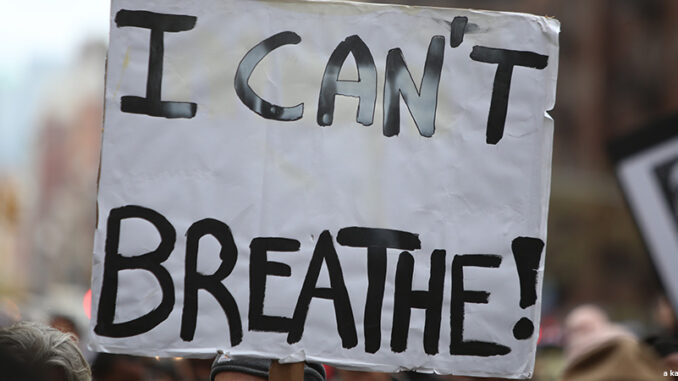
George Floyd’s Death Spurs Public Protests
Last week, a 46-year-old Minneapolis man named George Floyd was killed by police officers. Floyd–who was unarmed–was handcuffed and made to lie face-down on the street while an officer named Derek Chauvin kneeled on his neck. Bystander video of the incident shows Floyd begging for the officer to stop and saying that he can’t breathe and that he was in pain. Floyd became one of the latest African Americans to die as a result of police actions during an arrest. Floyd did not resist arrest or exhibit force. He was being detained by the police for allegedly forging a check at a convenience store.
The incident set off protests in cities all over the United States, beginning in Minneapolis but soon spreading across the United States. Protestors originally called for the four officers involved to be arrested and charged with murder. The three other officers who assisted Chauvin during Floyd’s arrest did not prevent Chauvin’s actions. They were later fired. In the initial investigation of the incident, it was revealed that Derek Chauvin had eighteen previous complaints against him. Chauvin was arrested on third-degree murder charges.
The tone of the growing protests in other cities became more focused on racism and police use of excessive force. Throughout Minneapolis and other cities as far away as Atlanta, Georgia, and Columbus, Ohio, police in riot gear responded to protest crowds with tear gas, crowd control tactics, and arrests. By the weekend of May 31, governors had begun calling in the national guard to maintain order in cities.
Dig Deeper Floyd’s death is the third time recently that strained race relations have been in the spotlight. Use Internet resources to write a short paragraph about the incidents involving Amy Cooper and Ahmaud Arbery.
Conventions vs. Coronavirus
This presidential election year, the Democratic National Convention has received the bulk of the attention: first, as the primary season unfolded to determine a candidate, and then because of the decision to delay the convention by a month due to concerns about COVID-19. But now, it’s the Republican National Convention’s turn in the spotlight.
This event is scheduled to take place as originally planned in Charlotte, North Carolina, at the end of August. Last week, however, President Trump threatened to move the convention if North Carolina’s governor Roy Cooper couldn’t guarantee full attendance at the event. In other words, Trump is demanding that social distancing guidelines not be in effect at the convention. Meanwhile, the governor and state health officials are asking the RNC what their plans are for how to keep people safe. (The event is expected to draw close to 50,000 people.) So far, the Republican National Committee has responded with an eight-point plan for safety that would include thermal scans of attendees, health checks and questionnaires, and lots of hand sanitizer readily available. It does not, however, include facial coverings or social distancing procedures.
A few days ago the president called Governor Cooper directly. Trump said he wanted the convention to go on as planned, with no masks or social distancing at all. This is despite the fact that the number of COVID-19 cases in North Carolina continues to grow, with a record-high number of deaths and hospitalizations recorded on May 27. The deadline to move the event is set for June 3.
What Do You Think? Imagine that you are a resident of Charlotte, North Carolina. Would you prefer the RNC take place as planned, or would you rather it be moved to another city for safety reasons? Explain.
Share the Wealth?
It’s no secret that some school districts are better funded than others. But sometimes, huge inequities exist, even between neighboring districts within the same county. A dramatic example of this is in New York state, where a student in the wealthiest district in the county receives $22,006 more per year in funding per student than the poorest district. In fact, the average funding difference between the wealthiest and the poorest districts in the country is about $6,000 per student. Why does this matter? Because the amount of money a district receives per student determines how much that district can spend on teacher salaries, textbooks, technology, school buildings, and more–and all of these factors are directly related to students’ educational performance and future success.
The reason for these dramatic differences comes down to how schools are funded. They are largely paid for by property taxes, which is money homeowners pay each year based on how much their property is worth. So a district with a lot of wealthy homeowners is obviously going to receive more funding than a district in a poorer neighborhood. But how to fix this problem? One nonprofit group, EdBuild, has proposed a radical idea. They suggest that property taxes be collected as usual, but then they should be spread out equally between the districts in a county (or even throughout the whole state). That means that regardless of the wealth of the neighborhood you come from, your school district would receive the same amount of money as the wealthier districts around it.
Thirteen states in the country already do this. And according to EdBuild’s report, if such a policy was put into place, two out of every three U.S. students would receive equal or greater funding than they do right now, with an average increase of about $1,000 per student. But we shouldn’t look for any sweeping changes just yet: a policy like this would mean that one-third of students would receive less funding, which makes it a hard sell to people in wealthier districts that stand to lose the most.
What Do You Think? Do you think a “share the wealth” policy like the one EdBuild suggests is a good idea? Why or why not?
Trump’s Twitter Problem

Lately, social media platforms have come under fire for promoting incorrect information. As a result, these companies have stepped up their efforts to warn viewers about information that may be inaccurate. Last week, Twitter slapped warning labels on two tweets about mail-in voting being corrupt, despite having no actual evidence that this was true. Both tweets came from the same person: the president of the United States. (Interestingly, he posted the same thing about mail-in voting to Facebook, but those posts weren’t flagged. That’s because Facebook takes the approach of not blocking any political speech, even when it is false or misleading.)
Trump responded that social media platforms often try to silence conservative voices, and threatened to take action to shut the company down. Twitter argued that it is nonpartisan and that its decision to flag the tweets was based on the fact that they’re false, not because they disagree with them.
But can Trump actually shut down a social media site? Lawyers say probably not. Private companies, such as Twitter and Facebook, have the right to police their own platforms, by setting rules and enforcing them. If politicians could shut them down just because they didn’t like what was being said, it would be a violation of the right to free speech, which is guaranteed in the First Amendment of the Constitution.
Days later Trump was again flagged by Twitter. This time, it was for his responses to the protests surrounding the murder of George Floyd in Minneapolis. Trump called the protestors “THUGS” and said that their looting would lead to shooting. Twitter responded by limiting the public’s ability to view and share the tweet.
